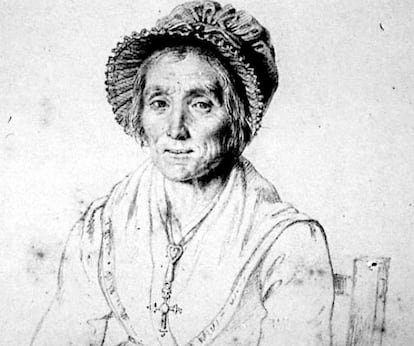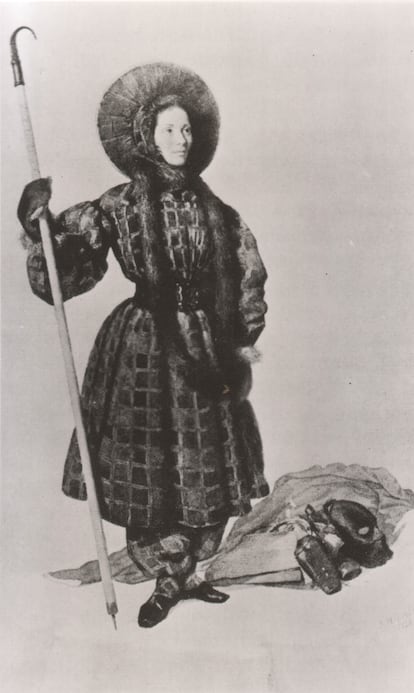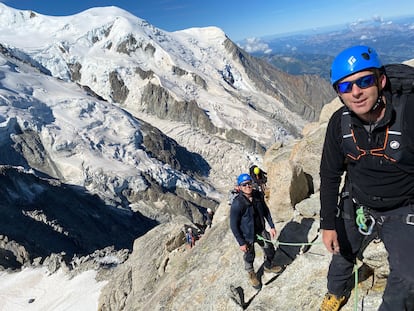The ‘Brides of Mont Blanc’: Europe’s earliest female mountaineers
In 1808, Marie Paradis summitted the highest peak in the Alps in attempt to achieve notoriety and escape a life of poverty. She did it dressed in a skirt, as the aesthetic and moral restrictions of the time demanded

The great mysteries of mountaineering are not about the mountains; they are about the people. It is in the lives of the sport’s protagonists where we find the spirit of an activity that is as easy to explain as it is complicated to understand. But sometimes, there is nothing to explain, because the motivations are obvious and public.
Such was the case with Marie Paradis, the first woman to summit western Europe’s highest peak, Mont Blanc (4,810 meters). Paradis wasn’t interested in scientific or personal discovery, or exploring the mysteries of alpine heights. Her motivation was a purely practical one, and in fact, may represent the first case of mountaineering as marketing. Simply put, Marie Paradis realized that if she became famous for being the first woman to climb Mont Blanc, she could make a better living, serving meals to tourists and mountaineers in Chamonix, the town at the base of the famous peak. Paradis hoped to escape poverty, but her options were limited, and she could neither read nor write. So, she decided to become the first woman – and one of the first people outside the circles of bourgeois and aristocratic elites – to set foot on Mont Blanc, encouraged by local guides who wanted the experience of climbing the summit to be more accessible to common people.
In 1786, the guide Jacques Balmat and the physician Michel Paccard were the first to ascend Mont Blanc, but by 1808, the towering peak remained a mysterious and terrifying place for anyone other than Balmat, who guided Swiss and English aristocrats to the top. Twenty-two years had passed since his famous first ascent, but Mont Blanc had still seen less than a few dozen summits.
Stories from the time differ: some say that it was Balmat who insisted that Marie Paradis take on the mountain. But according to one account written by Alexandre Dumas, author of The Three Musketeers, Paradis was the one who sought out the guide to ask to join the expedition he was leading, which included five men, all residents of Chamonix. Paradis was 30 years old at the time, and worked as an innkeeper.

The excursion lasted three days and was quite an ordeal: near the summit, dressed in a skirt, as the aesthetic and moral restrictions of the time demanded, Paradis suffered a severe case of altitude sickness. She slipped, fell, and suffered so much that at one point she begged her companions to throw her into the nearest crevasse to end her misery. But they did not abandon her: Balmat and the rest of the team helped pull and push her up the rest of the mountain. “I felt my legs give out and I asked Balmat to slow down,” she said in an interview with Dumas. Some accounts claim that she reached the summit on July 14, 1808, on the backs of her guides; others, however, say that she managed to reach the top on her own.
After descending the mountain, residents of Chamonix celebrated her pioneering success, and Paradis was able to move into a house where, from then on, she would cook meals for expeditions returning from Mont Blanc. However, the history of mountaineering has been reluctant to recognize her as the first female mountaineer. It is not the facts of her feat that are in dispute, but the motivations. This is why many accounts point to Henriette d’Angeville – the second woman to set foot on the summit of Mont Blanc, 30 years after Paradis – as the first true female mountaineer.
The differences between the two could hardly be more pronounced. An unmarried and childless aristocrat, d’Angeville was enamored the first time she caught sight of the white peaks of Mont Blanc. She knew she wanted to summit it, and she set out to make her dream a reality. Taking advantage of the privileges afforded by her class, d’Angeville prepared herself thoroughly: she visited a doctor, who warned her about the dangers of altitude sickness and the severe headaches that would accompany her to the summit. Nothing to worry about unless you start spitting blood, the doctor assured her. And d’Angeville had been training for years: since she was a child, she had enjoyed long mountain hikes, and she knew she would need to build “sturdy” legs to measure up to the challenge. So she trained. She also knew that she would need the maximum comforts available, to ensure everything was on her side: she hired six guides loaded like mules with enough provisions for three days and everything else she would need to spend the night at 3,000 meters above sea level.
At the time, there were no mountain shelters on Mont Blanc, so the aristocrat slept in furs and blankets. On the mountain – out of sight of society, so as to not cause a scandal – she swapped her skirt for a pair of pants that she had custom tailored to be more comfortable. The French aristocrat even changed her diet in preparation for the summit, replacing her usual wine with tea. Henriette d’Angeville had a genuine passion for the sport – a love that went beyond just the whims of a rich woman bored by worldly distractions. Recreational mountaineering would not arrive until 1860 or so, but d’Angeville found the freedom to express herself in accordance with her need to experience nature at its wildest.
A party in Chamonix
Her ascent of Mont Blanc was nowhere near easy. Indeed, like Paradis and others, she suffered from altitude sickness. But she never thought about giving up, and she took notes in a diary along the way and tracked her pulse at different altitudes: from 64 beats at rest to, at one point, while waiting for her guides to carve steps in the icy snow, 136.

When weakness finally hit her, d’Angeville told her guides that if she were to die, they should carry her to the top and leave her there. But tragedy was avoided: d’Angeville reached the summit, where two of her guides, ignoring the conventions of the time, lifted her into the air so that she could reach higher than “any man.” On her return, the residents of Chamonix received her with a huge party, to celebrate the triumph of the 44-year-old French aristocrat. The first to congratulate her was Marie Paradis, who was 60 years old by that time, and would die one year later. Paradis made it clear that the honor of the first true female ascent of Mont Blanc should go to d’Angeville. “I was dragged, carried and pushed up there,” she admitted.
From that day on, Henriette d’Angeville was known as the “Bride of Mont Blanc,” and she would go on to conquer summits until the age of 69, proving that her passion was both genuine and ahead of its time. More than 200 years have now passed since Marie Paradis suffered up the slopes of Mont Blanc, where to this day, guides continue to string along their assorted clientele: some on their way to the adventure of their lives, others to snap a photo for “likes” on social media.
Tu suscripción se está usando en otro dispositivo
¿Quieres añadir otro usuario a tu suscripción?
Si continúas leyendo en este dispositivo, no se podrá leer en el otro.
FlechaTu suscripción se está usando en otro dispositivo y solo puedes acceder a EL PAÍS desde un dispositivo a la vez.
Si quieres compartir tu cuenta, cambia tu suscripción a la modalidad Premium, así podrás añadir otro usuario. Cada uno accederá con su propia cuenta de email, lo que os permitirá personalizar vuestra experiencia en EL PAÍS.
¿Tienes una suscripción de empresa? Accede aquí para contratar más cuentas.
En el caso de no saber quién está usando tu cuenta, te recomendamos cambiar tu contraseña aquí.
Si decides continuar compartiendo tu cuenta, este mensaje se mostrará en tu dispositivo y en el de la otra persona que está usando tu cuenta de forma indefinida, afectando a tu experiencia de lectura. Puedes consultar aquí los términos y condiciones de la suscripción digital.
More information
Últimas noticias
Mexico seeks to shore up its defenses following US incursion in Venezuela
Hope gives way to uncertainty among Venezuelan exiles in the US after Maduro’s capture
Cubans look to Venezuela fearfully after Trump’s incursion: ‘We could be next’
The operation in Venezuela to capture Maduro threatens to widen the cracks in the MAGA movement
Most viewed
- Alain Aspect, Nobel laureate in physics: ‘Einstein was so smart that he would have had to recognize quantum entanglement’
- Gilles Lipovetsky: ‘If you want to live better and fall in love, take Prozac, don’t look to philosophy’
- Alvin Hellerstein, a 92-year-old judge appointed by Bill Clinton, to preside over Maduro’s trial in New York
- Cuba confirms death of 32 of its citizens in the US attack against Venezuela
- Why oil has been at the center of Venezuela-US conflicts for decades










































